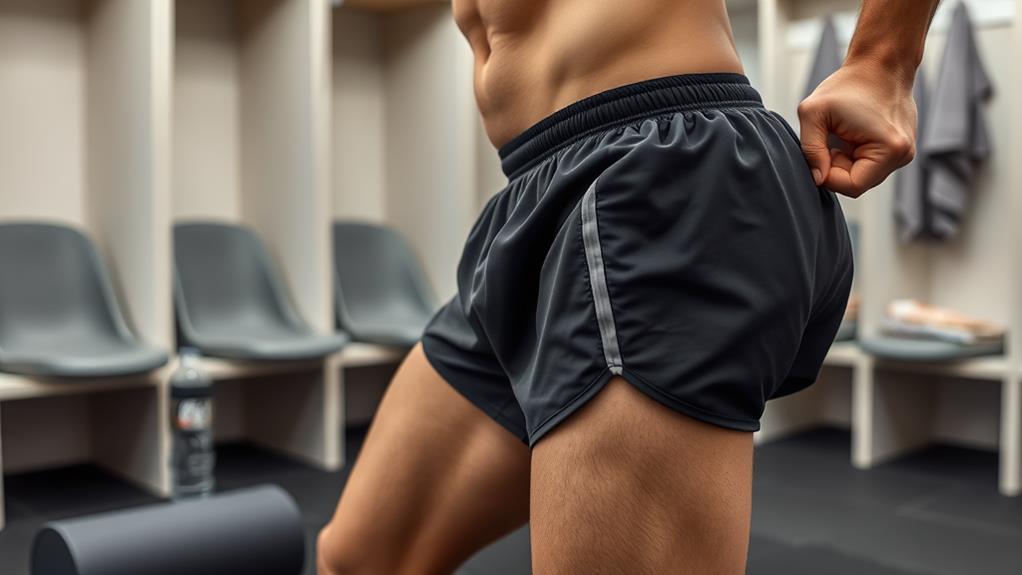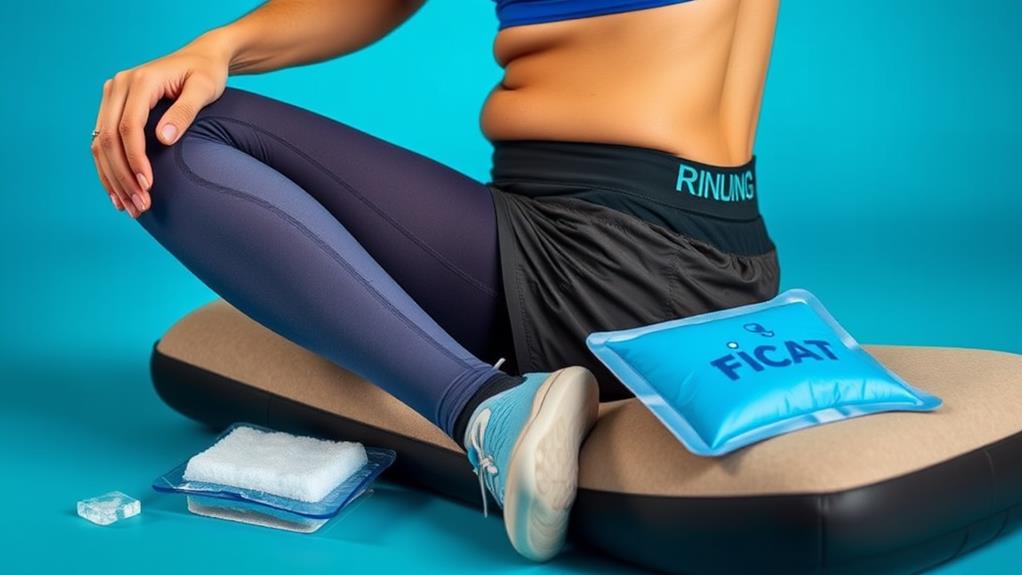As an Amazon Associate I earn from qualifying purchases.
Hemorrhoids pose unique challenges for athletes, affecting 25-30% of those in high-impact sports. You're at higher risk due to increased intra-abdominal pressure, constipation, and dehydration. To manage this condition, modify your routine with low-impact activities and pelvic floor exercises. Focus on prevention through proper nutrition, hydration, and lifting techniques. Treatment options range from sitz baths to minimally invasive procedures. Prioritize recovery and performance management by incorporating stretching, strengthening exercises, and a holistic approach to healing. By understanding the specific issues athletes face, you'll be better equipped to tackle this common but often overlooked problem.
Understanding Hemorrhoids in Athletes

Hemorrhoids frequently plague athletes, particularly those involved in high-impact sports like cycling, running, and horse riding. This condition affects an estimated 25-30% of athletes, with symptoms often worsening during intense training or competition periods. If you're an athlete, you're more susceptible to hemorrhoids due to increased pressure on the veins in your anal region during physical activity.
Several factors contribute to this heightened risk. Intense exercise can lead to increased intra-abdominal pressure, which puts strain on the rectal area. Additionally, athletes often struggle with constipation and dehydration, further exacerbating the problem. These issues can cause the veins in your anal region to swell and become inflamed, resulting in hemorrhoids.
Athletes with hemorrhoids may experience rectal bleeding, pain, and itching, which can profoundly impact their performance and quality of life. It's vital to recognize these symptoms early and seek prompt treatment. Ignoring the problem or delaying treatment can lead to complications such as anal fissures, abscesses, and chronic pain. By understanding the unique challenges hemorrhoids pose to athletes, you can take proactive steps to prevent and manage this condition effectively.
Exercise Modifications for Relief
Having understood the challenges hemorrhoids pose to athletes, it's important to ponder how you can modify your exercise routine to find relief. To reduce pressure on your anal region and alleviate discomfort, incorporate low-impact activities like yoga, swimming, or cycling into your regimen. These exercises help maintain fitness while minimizing strain on the affected area.
Avoid or modify exercises involving heavy lifting, bending, or straining, as these can exacerbate hemorrhoid symptoms. Instead, focus on activities that improve circulation, such as walking or jogging, to promote healing and reduce inflammation. Regular exercise that doesn't aggravate your condition is vital for overall health and hemorrhoid management.
To strengthen the muscles supporting your rectum and anus, incorporate pelvic floor exercises like Kegels. These can help prevent hemorrhoid recurrence and improve your overall pelvic health. Additionally, modify your routine to avoid prolonged sitting or standing, which can increase pressure on the anal region.
Prevention Strategies

A proactive approach to hemorrhoid prevention is pivotal for athletes. You can markedly reduce the risk of developing hemorrhoids by incorporating regular exercise into your daily routine. This not only helps prevent constipation but also promotes overall digestive health. A healthy diet rich in fiber and omega-3 fatty acids is imperative for maintaining regular bowel movements and reducing inflammation in the pelvic area.
If you're involved in weightlifting or high-impact activities, it's paramount to use proper lifting techniques to avoid increasing pressure on your rectal veins. Stay hydrated by drinking at least eight glasses of water a day, especially if you participate in endurance sports. This will help soften your stool and reduce the risk of hemorrhoids.
Establish good bowel habits by creating a regular routine and avoiding prolonged sitting on the toilet. This is particularly important if you experience frequent constipation or diarrhea. By implementing these prevention strategies, you'll not only reduce your risk of hemorrhoids but also improve your overall athletic performance and well-being. Remember, prevention is always better than treatment when it comes to managing hemorrhoids in your athletic career.
Treatment Options
When faced with hemorrhoids, what treatment options are available to athletes? You'll find several effective methods to manage hemorrhoid symptoms and alleviate pain. A sitz bath or warm bath can provide immediate relief from hemorrhoids by soothing the affected area. Simply sit in warm water for 10-15 minutes, several times a day, to reduce swelling and discomfort.
Over-the-counter hemorrhoid creams can also offer quick relief, especially for external hemorrhoids. These topical treatments often contain ingredients that numb the area and reduce inflammation. For more severe cases, your doctor might recommend prescription-strength creams or suppositories.
If you're experiencing significant pain and irritation, ice packs can help numb the area and reduce swelling. Alternating between cold and warm treatments can be particularly effective. In some cases, your healthcare provider may suggest minimally invasive procedures like rubber band ligation or sclerotherapy for persistent hemorrhoids.
Recovery and Performance Management

While treating hemorrhoids is important, managing recovery and optimizing performance are key for athletes dealing with this condition. You'll need to prioritize recovery techniques to reduce muscle tension and alleviate discomfort in the pelvic area. Incorporate stretching, foam rolling, and self-myofascial release into your routine.
To improve performance and prevent a recurrence, focus on strengthening your pelvic floor with exercises like Kegels and bridges. Adopt a holistic approach to manage inflammation and promote healing by maintaining a balanced diet, staying hydrated, and getting enough sleep.
Modify your exercise routine to avoid activities that exacerbate hemorrhoid symptoms. Opt for low-impact exercises such as yoga or swimming instead of heavy lifting or straining. Proper warm-up and cool-down routines, including dynamic stretching and gentle cardio, can help reduce muscle strain and promote circulation.
Frequently Asked Questions
How Do Athletes Deal With Hemorrhoids?
You'll need a strong athlete mindset to manage pain and adjust training. Make dietary changes, prepare mentally, and address performance impact. Don't let embarrassment stop you from seeking support. Communicate with teammates and coaches for understanding.
How Do You Shrink Hemorrhoids Without Surgery?
An ounce of prevention is worth a pound of cure. You can shrink hemorrhoids without surgery using hemorrhoid cream, witch hazel, sitz baths, cold compresses, or hemorrhoid bands. Topical treatments, herbal remedies, dietary changes, and lifestyle modifications are effective natural therapies.
Can You Play Sports With a Hemorrhoid?
Yes, you can play sports with a hemorrhoid, but you'll face sporty concerns and painful setbacks. You'll need to make athletic adjustments, consider physical limitations, and implement exercise modifications. Be prepared for competition worries, training interruptions, and potentially embarrassing moments during intense discomfort.
How Do Bodybuilders Deal With Hemorrhoids?
Like wrestling a thorny beast, you'll tackle hemorrhoids head-on. Modify your lifting techniques, adjust weightlifting pressures, and prevent straining. Conceal your discomfort, adapt training, and manage gym embarrassment. You'll make fitness compromises but overcome competition anxiety and painful posing.
Conclusion
You've navigated the rocky terrain of hemorrhoids in athletics, equipped with knowledge to tackle this often-overlooked issue. Remember, prevention is your best defense, but when flare-ups occur, you're now armed with strategies to modify your training and seek appropriate treatment. Don't let this bump in the road derail your athletic journey. With proper management and care, you'll be back on track, performing at your peak in no time.
Amazon and the Amazon logo are trademarks of Amazon.com, Inc, or its affiliates.
